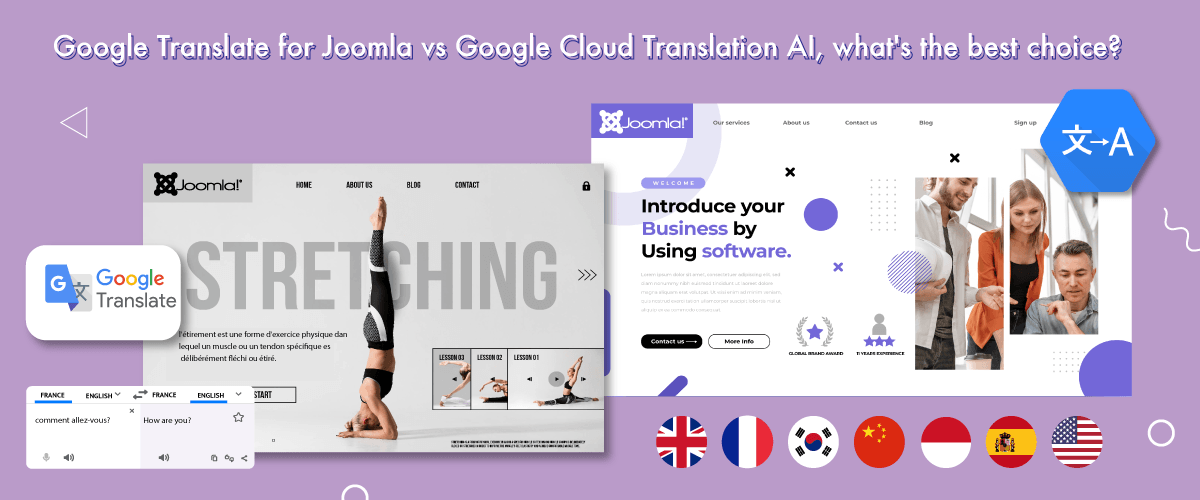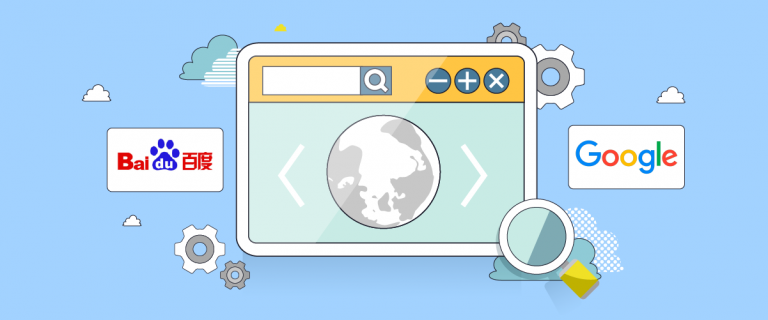Multilingual websites have become increasingly important for businesses and individuals. Overcoming language barriers and targeting diverse audiences is essential to reach and engage with international audiences.
In this blog, we will compare two popular solutions, namely Google Translate for Joomla and Google Cloud Translation AI, to help website developers find the best solution for their multilingual sites. Aimed at developers looking for efficient solutions, we strive to provide valuable insights in a friendly and easy-to-understand way.
So, let’s dive into the exciting world of multilingual websites and explore the strengths and differences between Google Translate for Joomla and Google Cloud Translation AI!
Understanding the need for multilingual websites
Multilingual websites are becoming essential for businesses and organizations to reach a global audience. By providing content in multiple languages, websites can attract the attention of users from various backgrounds.
This not only increases visibility, but also builds strong relationships with users from different countries. The advantages of multilingual websites include increased international reach and competitiveness, better user experience, and increased conversion rates and customer proximity.
While multilingual websites offer great benefits, implementing multilingual features can also be a challenge for developers. Then what are the things that are needed by a multilingual site?
In order to create and manage an effective multilingual website, a few things are needed.
- Content in multiple languages: multilingual sites require content to be provided in multiple languages to accommodate users from diverse backgrounds.
- Language selection feature: users should be able to easily select the desired language to access the content site.
- Language switcher: features that allow users to switch between languages quickly and easily.
- Localized content: content should be tailored to local culture and user preferences to create a relevant and engaging experience.
- SEO considerations: ensuring that multilingual sites are optimized for search engines and rank well in search results in multiple languages.
- User-friendly interface: website design should be intuitive and easily understood by users from different languages and cultures.
- Translation management system: use of a system that facilitates the management and regulation of content translation.
These are just a few things that are required for a multilingual Joomla site. To translate multilingual content, third party services are needed which will help you provide content in various languages.
Google is a platform that provides translation services through Google Translate and Google Cloud Translation AI. These two products have different service offerings.
Google Translate

Google Translate is an automatic translation service developed by Google. This service allows users to instantly translate text, documents and even conversations from one language to another.
The main function of Google Translate is to provide automatic translations to help users communicate and understand content in languages they don’t speak. This service can be used through the official Google Translate website or mobile application. While the translations are quite fast and easily accessible to anyone free of charge, the accuracy of the translation may vary depending on the complexity of the language and context.
Google Translate can also be used on WordPress, Joomla CMS to translate websites, namely through extensions. An extension that uses Google Translate as a reference is GTranslate.
GTranslate is a free translation service that allows you to automatically translate your website content into multiple languages. This service is not developed with special extensions for Joomla, but can be integrated with various platforms, including Joomla. GTranslate is widely used by site owners because of its free service. Even though it’s free, GTranslate doesn’t support many features, therefore there is another solution, namely Google Cloud Translation AI.
Google Cloud Translation AI

Google Cloud Translation AI is an artificial intelligence based translation service provided by Google Cloud Platform. It is a solution aimed at developers and enterprises who need more powerful and sophisticated integration of automatic translations in their applications.
The Google Cloud Translation AI function provides a more accurate and enhanced automatic translation service using artificial intelligence technology. These services can be easily integrated into applications, websites or services developed by users.
Google Cloud Translation AI provides more control and flexibility in customizing translations according to business or application development needs. Users can use custom models to improve translation accuracy in specific contexts or train language models themselves to identify specific terms or phrases.
The main difference between Google Translate and Google Cloud Translation AI lies in the target user and the functionality offered.
Google Translate is more suitable for general use and everyday use, while AI Google Cloud Translation is for developers and enterprises who need more accurate and customizable automatic translation in their business applications or services.
Well, one of the translation services based on Google Cloud Translation AI is Linguise. Linguise is an automatic website translation service, like Joomla. This service translation with AI. This model is known to be more sophisticated because it understands context and sentence structure in more depth, resulting in a more accurate and natural translation.
This time we will compare the features between GTranslate which is based on Google Translate and Linguise which is based on Google Cloud Translation AI and uses AI translation.
GTranslate VS Linguise using Google Cloud Translation AI
The comparison between GTranslate and Linguise extensions using AI translation in the context of website translation can be described as follows:
1. Translation technology
- GTranslate: GTranslate uses traditional machine translation based translation technology and implements translation on the client side using JavaScript. Despite several improvements, this translation method is not as complex as AI translation.
- Linguise: Linguise uses translation with AI to provide website translations. AI translation is more sophisticated because it leverages neural networks to understand the context of the whole sentence, resulting in a more natural and accurate translation.
2. Translation quality
- GTranslate: The quality of translations on GTranslate varies depending on the language and complexity of the content. Translations may not always be accurate and may affect the user experience.
- Linguise: Linguise provides a more accurate and natural translation. AI translation allows for a more precise translation and is more appropriate to the context of the sentence.
3. Customization
- GTranslate: GTranslate provides some customization options, such as setting the target language and translation style, but customization is more limited compared to Linguise.
- Linguise: Linguise provides a greater degree of customization through advanced translation addition rules. Users can control which content should be excluded from the translation process or edit translations directly.
4. Service and support
- GTranslate: GTranslate is a public extension available to use for free or for a fee, depending on feature selection and support. Customer support may be limited for free users.
- Linguise: Linguise is a paid service that provides more in-depth customer support via email or live chat. Weak support team assists users in integrating translations exactly according to their needs.
5. Language availability
- GTranslate: GTranslate provides support for multiple languages covering common and popular languages around the world. However, support for less common languages may be more limited.
- Linguise: Linguise also supports multiple languages, including more specific and less general languages or traditional languages such as Chinese. Broader language support can provide flexibility for companies or organizations with diverse, multilingual target audiences.
6. Security and privacy
- GTranslate: GTranslate is a public extension that collects text and language usage data to improve translation quality. User data may be used for analysis or service improvement purposes.
- Linguise: As a paid service, Linguise places the security and privacy of user data as a top priority. User data transmitted or used for the translation with AI training model is kept strictly confidential in accordance with a strict privacy policy.
7. Integration and scalability
- GTranslate: GTranslate provides extensions for multiple platforms such as WordPress, Joomla, and Shopify, making it easy to integrate with existing websites. However, scalability for high translation volumes may be limited.
- Linguise: Linguise also provides integration with popular platforms, as well as APIs for further integration. In addition, Linguise is designed for high scalability, which makes it suitable for companies with high traffic or large-scale translation needs.
8. Translation updates
- GTranslate: GTranslate performs translation automatically with static translation based on the target language selected by the user. Translation updates may require a manual process.
- Linguise: Linguise uses dynamic translation which is updated automatically every 3 months with AI translation. Users can easily update translations in real-time via the Linguise user interface.
9. User experience
- GTranslate: GTranslate offers a translation button on the frontend that is easy for users to use. However, translation control and customization may be limited.
- Linguise: Linguise provides a sophisticated user interface, which enables users to manage translations more precisely. Advanced translation accent setting features and a subtitle editor provide further control over translations.
10. SEO & URLs translation
- GTranslate: GTranslate can translate website content automatically, however, this translation is usually generated via JavaScript translation done on the client side. Also the free tool GTranslate does not provide URL translation. This can cause problems in storing content by users or search engines.
- Linguise: Linguise translation results are automatically indexed according to the respective target countries, besides that the links have also been automatically translated. With this approach, the translated content can be indexed better by search engines, because search engines can see previously generated translated versions.
11. Advanced translation exclusion rules
- GTranslate: Google Translate provides no advanced controls or in-depth translation restrictions. Users cannot specifically specify words, phrases, or certain parts of the content that they do not wish to translate or exclude from the translation process.
- Linguise: Linguise provides an advanced translation exclusion rule feature that allows users to specify exactly which parts of content should be excluded from the translation process. This allows users to control which content is unnecessary or unsuitable for translation.
12. Frontend translation
- GTranslate: Google Translate translation results cannot be changed or edited according to our wishes. This makes the user does not have full control over the translation results.
- Linguise: Linguise provides frontend translation solutions. In addition to automatic translation, Linguise also provides further control with an advanced translation melody rule feature and the ability to edit subtitles directly through the user interface.
13. Translation accuracy
- GTranslate: GTranslate has translation accuracy that varies depending on language and context. For common language and simple content, the results tend to be better, but for more complex language or technical content, the quality may suffer.
- Linguise: Using AI translation technology, Linguise can provide a higher level of translation accuracy and is closer to human translation, especially for more complex languages and technical content.
14. Prices
- GTranslate: the GTranslate extension provides a free version, but with limited features, such as SEO NOT included. To be able to experience many other features, including SEO, you have to pay starting from $300 per year
- Linguise: Linguise also provides a free trial version and then prices are $165 per year. Linguise has provided the best features, such as SEO & URL translation, frontend, etc.
However, Linguise provides more advanced features and control when it comes to customizing translations through advanced addition rules. In addition, Linguise provides more accurate and natural translations, which can improve the user experience and the overall quality of the translation.
GTranslate, although it provides some customization options, has limitations in terms of customization and translation quality compared to Linguise with AI translation.
That’s more or less a comparison between GTranslate and Linguise based on Google Cloud Translation AI. Next, between GTranslate and Linguise, what should you pay attention to when you want to choose a Joomla translation plugin?
How to choose the best choice Joomla translation plugin?
When choosing a Joomla translation plugin, there are several important factors to consider to ensure it meets your website’s needs and delivers a smooth multilingual experience. Here’s what to look for:
- Translation technology: check if the plugin uses advanced translation technologies like AI translation or professional human translation services. Translation with AI technology can provide more accurate and natural translations.
- Supported languages: ensure the plugin supports the languages you need for your multilingual website. Check if it covers all the target languages you want to translate your content into.
- Translation quality: assess the quality of translations provided by the plugin. Look for user reviews and ratings to gauge the accuracy and fluency of the translations.
- Customization options: look for a plugin that allows you to customize translations to suit your brand’s tone and style. A good translation plugin should allow you to adjust translations and exclude specific content from translation if needed.
- Ease of use: choose a user-friendly plugin that is easy to install, set up, and use. An intuitive interface will save you time and effort.
- Performance: evaluate the impact of the plugin on your website’s performance. Ensure it doesn’t slow down your site and provides fast translations.
- SEO friendly: check if the plugin’s translations are SEO-friendly. Translations should be indexed by search engines to maintain visibility and rank well in search results.
- Cost: evaluate the pricing model of the plugin. Some may offer free versions with limited features, while others may require a subscription or one-time payment.
By carefully considering these factors, you can choose a Joomla translation plugin that best aligns with your website’s requirements, language support, budget, and offers a seamless multilingual experience for your visitors.
Always test the plugin thoroughly before implementing it on your live site to ensure it meets your expectations and delivers the desired results.
Conclusion
In this article, we compare Google Translate for Joomla and Google Cloud Translation AI to help website developers find the best solution for their multilingual sites. Google Translate is an automatic translation service suitable for general use, but has limitations in translation accuracy.
On the other hand, Google Cloud Translation AI, especially with Linguise using AI translation offers more accurate and natural translations and advanced customization features, such as exclusion rules and frontend translation.
Taking into account the factors of translation technology, quality, customization options and language support, Linguise stands out as an excellent choice for website developers who wish to provide their users with an optimal multilingual experience. As such, choosing the best Joomla translation plugin should take into account the website’s needs and desired features, and Linguise can be an attractive option for achieving that goal.




